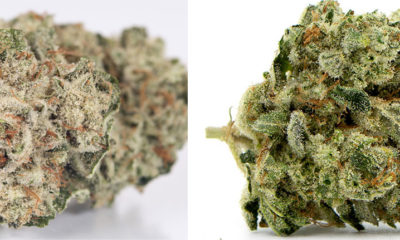Health
Understanding the Mechanisms of Medical Cannabis in the Human Body


The realm of medical cannabis opens up exhilarating possibilities for numerous scientists and physicians, presenting a natural avenue to address various human ailments. By comprehending the fundamental processes implicated in this therapy, we move a stride nearer to unearthing the treatment’s potential and utilizing it optimally to promote human well-being. In this enlightening piece, we shall explore the complexities of medical marijuana, spanning from its botanical makeup to its captivating molecular engagements within the human physique. We’ll cover topics such as how cannabinoids interact with cannabinoid receptors throughout our cells, what kind of therapeutic effects they can produce based on their interaction with these receptors, and how we can exploit them for medicinal purposes. So whether you’re already versed in medical botany or are just starting out your journey into this field of study – you’ve come to the right place!
Overview of cannabis and its chemical compounds
The topic of cannabis has stirred controversy for a considerable duration, eliciting diverse perspectives that are expressed through various channels. Nevertheless, upon further examination of the chemical constituents comprising this botanical specimen, we gain enhanced comprehension regarding its impact and its intricate interaction with human physiology. Within the domain of cannabis, numerous compounds coexist, yet two hold notable significance: THC and CBD – These compounds hold great importance and capture our attention. THC is primarily responsible for the plant’s psychoactive effects, while CBD is associated with medicinal properties such as pain relief and reducing anxiety. Although cannabis is commonly known for its recreational use, the potential health benefits of its chemical compounds are being researched and studied more closely than ever before. To find out more about this subject, visit https://elevate-holistics.com/get-a-medical-marijuana-card/pennsylvania/.
Investigating the impact of THC on the human mind and physique
In recent times, the utilization of cannabis has gained widespread acceptance among individuals, mirroring a shift toward mainstream culture. While it’s known to produce a sense of relaxation and euphoria, what happens to the brain and body when THC is introduced? This specific chemical compound has been discovered to engage with the endocannabinoid system, which governs various functions such as hunger, emotions, and sleep. Research indicates that THC can influence memory, focus, and cognitive abilities, albeit the degree of these effects may differ based on the amount and frequency of usage. As cannabis legalization continues to grow, understanding the effects of THC on the human brain and body will be crucial in making informed decisions about its use.


The impact of CBD on the endocannabinoid system
The endocannabinoid system (ECS) embodies a sophisticated web of receptors and neurotransmitters, akin to the intricacies of human physiology. Its paramount function lies in upholding equilibrium and homeostasis within our beings. Cutting-edge research has unveiled the profound influence of cannabidiol (CBD), a non-psychoactive component derived from cannabis, on the ECS. CBD interacts with various receptors in the ECS, leading to a multitude of therapeutic effects. This includes reducing inflammation, managing pain, improving mood and anxiety, and even potentially slowing the progression of certain diseases. By stimulating the ECS, CBD may help restore balance and improve overall wellness. As research on CBD and the ECS continues, we may discover even more benefits of this fascinating interaction.
How cannabis affects our mood and behavior
Cannabis, commonly referred to as marijuana, has been the subject of extensive discussions regarding its impact on human emotions and behavior. While some users find it to be a calming and relaxing experience, others report feeling anxious and paranoid. The main psychoactive component of cannabis is delta-9-tetrahydrocannabinol (THC), which binds to receptors in the brain and alters neurotransmitter release. This can result in changes in one’s mood and behavior, including altered perception of time, increased appetite, and decreased motivation. It’s important to note that the effects of cannabis can vary greatly depending on the individual, the strain, and the method of consumption. As with any substance, moderation is key when it comes to determining its effects on your own mood and behavior.
Examining the therapeutic potential of medical cannabis
As more states legalize medical cannabis, the therapeutic potential of this versatile plant is becoming increasingly apparent. Scientists and researchers are actively investigating the numerous possibilities of utilizing cannabis to relieve symptoms associated with a diverse array of medical ailments. These conditions span from persistent pain and anxiousness to epilepsy and multiple sclerosis. By harnessing its capacity to engage with the body’s endocannabinoid system, cannabis presents a human-like potential as a non-addictive and conceivably safer substitute for conventional pharmaceuticals. However, there is still much to be learned about the long-term effects of medical cannabis use, and more research is needed to fully understand its therapeutic potential. Despite these challenges, the future of medical cannabis looks bright, and patients and healthcare providers alike are hopeful about the many ways in which this remarkable plant can improve lives.
Conclusion
As we can see from exploring the science of cannabis, there is a range of effects this plant has on our bodies and minds. From disrupting our endocannabinoid system to enhancing or inhibiting aspects of our mood and behavior, there are many complex interactions that occur when we use cannabis. For some, certain compounds may produce more desirable effects than others, while for others they may be desired equally. It is often recommended that further research and experimentation be done before undertaking any cannabis-based treatments on an individual basis. Though much medical potential remains untapped at present, it is promising to note that advances in technology are increasing our understanding of its therapeutic applications for remedying otherwise debilitating conditions. Ultimately, as cannabis continues to gain acceptance throughout society it will become increasingly important to recognize the need for both education and regulation as we continue to develop a better understanding of its uses and effects.
-



 Growing6 years ago
Growing6 years ago12 Common Marijuana Leaf Problems and How to Fix Them
-



 Strains6 years ago
Strains6 years agoGorilla Glue #4 VS Gorilla Glue #2 – Strain Comparison
-



 Strains6 years ago
Strains6 years agoUGORG #1 Cannabis Strain Review
-



 Strains6 years ago
Strains6 years agoTropic Heat Cannabis Strain Review
-



 Growing6 years ago
Growing6 years agoWeed Measurements Guide: Weights, Quantities, Prices
-



 Strains6 years ago
Strains6 years agoSour Headstash Cannabis Strain Review
-



 Health6 years ago
Health6 years ago7 Proven Health Benefits of Cannabidiol: What is CBD & How Does it Work?
-



 Growing6 years ago
Growing6 years agoSour Diesel BX2 Weed Strain Review










